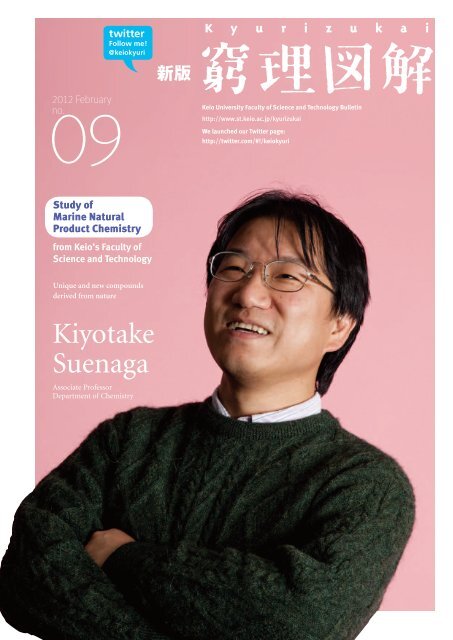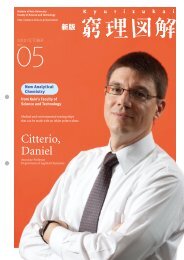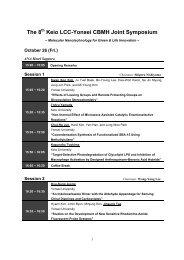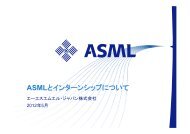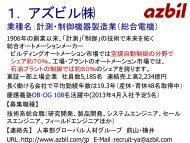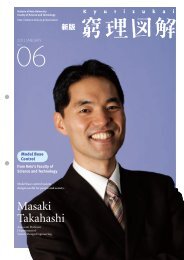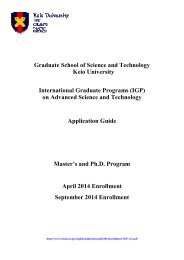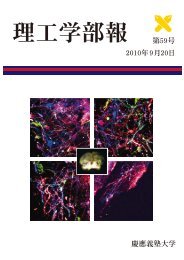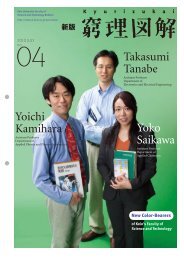Kiyotake Suenaga - Keio University
Kiyotake Suenaga - Keio University
Kiyotake Suenaga - Keio University
- No tags were found...
Create successful ePaper yourself
Turn your PDF publications into a flip-book with our unique Google optimized e-Paper software.
Ascidian(sea squirt)Assessment of biologicallyactive substanceSea hareSpongeCancer cellBiologicallyactive substance(unknown substance)Fig.2 Exploration of biologically active substancesBiologically active substances derived from marine organisms are availableonly in extremely small amounts, making it difficult to isolate the targetsubstance by purifying extraction materials by ordinary means. However, itis possible to isolate the target substance even from a very small amount ifwe use biological activity as a bench mark. You may compare it to ants thatcan locate sugar, attracted by its sweetness.installed at the <strong>Keio</strong> campus enablesa substance’s chemical structure to beidentified in a short period of time. If thechemical structure of a given substanceis too complex, an NMR with higherresolution, available outside the campus,may be used. More specific aspects of thesubstances are determined based on theirreactivity and crystal structure analysis.Once the structure has been identified,you can determine whether the substanceis really unknown.Bisebromoamide was the first subst ancediscovered from an extract of cyanobacteriathrough such an explorationprocess. “We named it ‘Bisebromoamide’because it was an amide containingbromine (Br) and found in cyanobacteriawhich were gathered in the seaside Bisedistrict of Okinawa,” says Dr. <strong>Suenaga</strong>. Hemakes it a rule to give a substance he hasdiscovered a name based on the place ofdiscovery and/or the main characteristicof its molecule. Bisebromoamide wassuccessively followed by the discovery ofbiselyngbyaside and leptolyngbyolides.And even a fourth substance is likely tobe discovered before long.That said, each of these substancesis available in only an extremely smallamount (several milligrams to severaltens of milligrams). This makes itdifficult to make detailed investigationinto properties and actions of thesesubstances. As a solution to obtain sufficientamount of substances, Dr. <strong>Suenaga</strong>is attempting artificial chemical synthesis.Synthesis methods for bisebromoamideand biselyngbyaside are expected to beestablished soon.Key points for successful researchDr. <strong>Suenaga</strong>’s research work nowappears to be progressing smoothly.But he could not find any promisingsubstance at all in the first two years.There are countless marine organisms.Why didn’t he switch to other organisms?“To tell the truth, I had been dealing withother marine organisms in my early years,but I couldn’t achieve visible results.That’s why I switched to cyanobacteria.Therefore, the idea of giving up cyanobacteriain a mere two years or so did n’toccur to me at all.” It seems that explorationof unknown substances also requirestenacity and toughness.A turning point came to him whenhe began collecting cyanobacteria ofdifferent varieties from what he hadbeen focusing on. “When talking aboutcyanobacteria, we tend to think, first andforemost, of those outstanding ones likeimpressive green algae. Having spenttwo years looking only at cyanobacteria,however, I suddenly noticed that cyanobacteriaalso exist that are plain and lessconspicuous,” he remarks. This change inapproach fueled his advance.Substances derived from marineorganisms: a focus of attention“Among the many substances I know,bisebromoamide is unique in that itcontains D-amino acid, bromine (Br) andt-butyl group.” Substances derived frommarine organisms are intriguing notmerely because of their structures. Dr.<strong>Suenaga</strong> continues, “Recently I’m oftenasked by researchers of my acquaintance,‘Do you have any interesting substance?’So I send a sample. Later on, I receive areport from that researcher saying thathe/she found a particular action.” Forexample, Prof. Je-Tae Woo of Chubu<strong>University</strong> informed him of the possibilitythat biselyngbyaside might become aneffective remedy for osteoporosis.Osteoporosis is a disease for whichno effective remedy has been foundto date. So biselyngbyaside has cometo the fore as the key substance foran osteoporosis remedy. Dr. <strong>Suenaga</strong>humbly says, “Although I can gather andisolate unknown substances, I’m not inan environment where I can examine allof them in detail as to what actions thesesubstances have. So I really appreciateother researchers’ efforts and support inthis regard.” Despite his humble comment,it may not be an exaggeration tosay that such a co-research frameworkcan exist only because the substancesdiscovered by Dr. <strong>Suenaga</strong> have beenintriguing enough.On March 23, 2011, the ChemicalDaily ran an article reporting that fullscalepharmaceutical developmentendeavors would be undertaken usingthe substance discovered by Dr. <strong>Suenaga</strong>.Adding “Pharmaceutical developmentrequires the highest possible safety andefficacy,” he appears to be not placingtoo much expectation on the proposedphar maceut ical development andis determined to steadily pursue hisresearch work. Yet, at the same time, heproudly says “Should it fail to come tofruition as a new drug, the significance ofcontinuing in-depth quest of unknownsubstances remains unchanged becauseit will eventually help to shed light onmysteries of life phenomena.”“Many marine organisms have noshells to protect themselves and are slowin moving, making them apparentlydefenseless. Despite that, they aresurviving. Decades ago, some scientiststhought that such organisms must havea certain kind of defensive substancethat enables them to survive despitetheir apparent weakness. This is believedto be the starting point of explorationof unknown substances peculiar tomarine organisms. I’m not sure if thishypothesis is true or not, but as far as myresearch endeavors are concerned, I canconfidently say that marine organismsdo have many intriguing substances thatare not yet known to us,” concluded Mr.<strong>Suenaga</strong>. Natural product chemistry isbound to attract more and more attentionin the years to come. (Reporter & text writer: Akiko Ikeda)*1: One of the methods to isolate a substance utilizingdifferences in affinity with the carrier.*2: An action that inhibits growth of cancer cells.3
InterviewListening to what Associate Professor <strong>Kiyotake</strong> <strong>Suenaga</strong> has to sayI owe what I am today tomy respected teacherDiscovering one unknown substance after another from marine cyanobacteria,Dr. <strong>Suenaga</strong> endeavors to approach and elucidate the usefulness of suchsubstances. He has inherited his preparedness both as a researcher andeducator to his respected teacher whom he encountered as a university student.Once a young student lacking an interest in chemistry, why and how did hebecome bent on the exploration of unknown substances?How did you spend your childhood?I was born in Aizu in FukushimaPrefecture and raised in Sendai in MiyagiPrefecture. Since I grew up in a leisurely,stress-free environment, there was nobodywho attended a cram school. Also, I wasnever told by my parents to study hard. Sountil I graduated from junior high school,I had rarely studied at home.As a small boy, I thought to myselfthat I would find employment withthe Japan National Railways (now JR)in the future. For me this seemed tobe a natural course of life since threegenerations of my family, from my grandgrandfatherto my immediate father, hadworked for the National Railways. So Iwas raised in official National Railwayshousing. The fact is, my father wasone of the first-generation drivers ofthe Tohoku Shinkansen SuperExpress.When I was an elementary school boy,my father was studying hard to becomea Shinkansen driver to prepare for theTohoku Shinkansen line opening, whichI still remember. My own son appears torespect his grandfather much more thanhis father (myself) because he has no ideaabout what I’m doing.What was the impetus for you to makea decision to specialize in chemistry?I was once reaching for the universe.In fact, my interest had been in physicsrather than chemistry until I becamea university student. But by the time itwas time for me to choose a lab to studyin, my interest had shifted to naturalproducts and other complex substances.At Nagoya <strong>University</strong> in thosedays, however, studying in the organicchemistry group of the Graduate Schoolof Chemistry required a kind ofresolution. It was because there were twoprofessors’ labs available – Prof. RyojiNoyori who was later to win a NobelPrize, and Prof. Kiyoyuki Yamada, myteacher, both famous for being very strict.I finally decided to join Prof. Yamada’s lab.(Left) Marine cyanobacteria are being extracted using an organic solvent. After several days ofextraction, the liquid is filtered and enriched inot an extract. / (Right) For research involving chemicalsynthesis, thin layer chromatography (TLC) is employed to examine the progress of reactions. TLC canalso be used as a means for separation.What was the atmosphere of your lab?As a newcomer, I had no idea of whatthe Yamada lab was like, but soonI found that the lab was with greattraditions. Dr. Yoshimasa Hirata, thepredecessor and teacher of Mr. Yamada,is famous worldwide for his research ontetrodotoxin (globefish poison). Furthermore,Dr. Osamu Shimomura, awardedthe 2008 Nobel Prize in Che mistry forhis research into green fluorescent proteinfound in jellyfish, had once studied in Dr.Hirata’s lab. By chance, I put myself in anenvironment that is one of the greatestcenters of natural product chemistry.Even today, I make it a rule to introducemy respected teacher Mr. Yamada’sresearch work “Carcinogenic Substanceof Bracken” at the beginning ofthe “Chemistry of biologically activemolecules” class work for juniors of theDepartment of Chemistry.What was the first research work inyour life like?My first research theme was chemicalsynthesis of Aplyronine A. This substancecan be obtained from sea hares, a marineorganism that looks like a large slug.Aplyronine A is an anticancer substancediscovered by the Yamada lab. It interactswith actin, the knowledge of which wasquite innovative in those days. I camewithin an inch of success by the end ofthe second year of the master’s course.But the last reaction would not takeplace, which put me at the end of myrope after all. Reluctantly, I had to go farback to a substance of the early stage andrebuild the synthesis method. I was likea climber who reached the ninth stageof a mountain but was suddenly pulledback down to the third stage. Even so, Iremained steadfast, thinking I should notabandon the project halfway. It was at theend of the first year in the doctor’s coursethat I finally succeeded in the synthesis.Incidentally, Dr. Hideo Kigoshi(<strong>University</strong> of Tsukuba), a disciple of Dr.Yamada, has taken over the research intothe substance’s action mechanism. At arecent academic meeting I had an opportunityto listen to Dr. Kigoshi’s lecturethat mentioned a new development in thestudy of the action mechanism.4
<strong>Kiyotake</strong> <strong>Suenaga</strong>Dr. <strong>Suenaga</strong>’s specialty is marine natural productchemistry. He is engaged in exploration of biologicallyactive substances. Currently, his focus is on marinecyanobacteria. In 1992, he was enrolled in Nagoya<strong>University</strong>’s Graduate School of Science. In 1995, heleft the doctor’s course to become a research assistantfor the Department of Chemistry, Faculty of Science ofthe university. In 1997, he acquired a doctor’s degree(in science). After serving as a research assistantfor Shizuoka Prefectural <strong>University</strong> (PharmaceuticalDepartment) then as an assistant professor for the<strong>University</strong> of Tsukuba (Department of Chemistry), in2006 he assumed the current position as an associateprofessor for Department of Chemistry, <strong>Keio</strong> <strong>University</strong>Faculty of Science and Technology. Dr. <strong>Suenaga</strong> washonored with the Inoue Research Award for YoungScientists in 1998 and the Chemical Society of JapanAward for Young Chemists in 2003.I’d like my students toacquire comprehensiveknowledge of theirspecialties andrelated fields.Completion of the Aplyronine Asynthesis method urged me to ask Dr.Yamada for permission to isolate it anddetermine its structure myself. It had beenmy wish to do the task if I had advancedto the doctor’s course. I wanted to finda new substance on my own instead ofsynthesizing something that has beenisolated and structure-determined bysomeone else. Dr. Yamada told me rightaway, “Isolate it yourself.” I felt that myteacher must have known my wish beforeI put it into words.Using an extract equivalent to 250kilograms of the sea hare, I patientlyrepeated the isolation process over andover again and finally obtained about0.5mg of substance called Aurilide.Your research work seems to requiregreat endurance. What are you doingfor diversion?My hobby is listening to music. Soonafter joining the university, I began goingto concerts in and around Nagoya. Atone time, I went to concerts 50 to 60times a year. Do you know there are nineprofessional orchestras in Tokyo? It’san exceptional boon to classical musicenthusiasts like me. I’m a subscriber of theTokyo Symphony Orchestra. Yesterday Iwent to a concert by the NHK SymphonyOrchestra. At some concerts, childcareservices are even available, which allowsme to place my small sons (aged 6 and3) under childcare. Sometimes I take my9-year-old daughter to concerts, but sheoften sleeps during the performance. Ithink it’s OK because I frequent concertsfor my own pleasure (laughter). Anyway,enjoying music is truly refreshing.I’m also trying to spare as much timeas possible for communicating with mychildren. It’s my rule to eat breakfast anddinner with my small ones. Since myhome is close to the campus, I go homefor dinner and take care of their bathing,then go back to the campus again forwork. Being with children is anotherdiversion for me.What a wonderful papa! How are youdealing with your students?You may call me a strict teacher.Every week we have one rinko sessionwhere lab students take turns reading atextbook written in English, a magazinemeeting where students introducescientific journals they have read, and astudy meeting where they learn aboutinstrumental analysis. Of the over ten labstudents, five take charge of such meetingsevery week, meaning that one student willtake charge of one meeting every two tothree weeks. This is a rather heavy burdenon the students as it requires significantamount of preparatory study.Experiments are one important thing,but there is another more important thing;I would like my students to build up theiracademic capability by learning broadly.Concerning our specialty, I’d like themto acquire comprehensive knowledge oforganic chemistry. Suppose a studentwho is engaged in isolation and structuraldetermination lacks knowledge of organicsynthesis reactions, or a student who isfocused on synthesis of a natural productknows nothing about biosynthesis. I don’twant my students to be like that.Looking back at myself, I was thoroughlyeducated during my studentdays. In retrospect, many of the toughexperiences I had as a student are nowproving to be assets for me. A friend ofmine who found employment with aprivate company says the same thing.◎ Just a word from . . . ◎● Student M: I have an unforgettablememory. Due to our mistake or otherreason, we knew that our reservationfor ro oms at a f amily-r un inn inTokunoshima Island was not made. Inthe gathering dusk, I solicited the inn toprovide us with two rooms (connected)somehow or other and finally secured therooms. Even under such circumstances,we energetically gathered cyanobacteria aswe normally would. Our teacher’s poweris always a driving force for us students.● Student N: I joined this lab becauseit has been my wish to create a varietyof substances by using organic chemicalreactions. I’m happy and comfortablehere because I’m allowed to do almostwhatever I want. When I’m in trouble, myteacher thinks together with me and iswilling to listen to my proposals. (Reporter & text writer: Kaoru Watanabe)For the full text of this interviewhttp://www.st.keio.ac.jp/kyurizukai
hours,hoursDays in the Life of <strong>Kiyotake</strong> <strong>Suenaga</strong>Weekday November 25, 2011 (Friday)6:30 〜Woke up, ate breakfast, and read newspapers.8:00 〜Saw my eldest daughter off to school and lefthome for the campus to work.8:30 〜Arrived at the lab and copied materials forclass work.9:00 〜Class work (“Chemistry of biologically activemolecules” for juniors). The theme of today’slecture was ß-Lactam antibiotics. This themeis close to my specialty, so I enjoyed giving alecture.10:40 〜Time for office work, such as processing ofslips.12:00 〜Lunch (box lunch)12:30 〜Discussion with students. Then I receiveda call that something was wrong with themeasuring instrument (NMR), but it was soonfixed by making some adjustments.15:00 〜Conducted some research, read theses, etc.18:00 〜Went home temporarily. On the way, Idropped in at my daughter’s music school topick her up and escorted her back home. Tooka bath together with children (two elder onesfor today). Then ate dinner.20:00 〜Went back to the lab. Had a discussion withstudents, which might help solve a problemthat was hard to deal with.22:00 〜Set the NMR for all-night measurement. It’sbeen a long time for me to measure by myself.Anxious about the run of events, I took a lookat the state of measurement several times.0:00 〜Returned home. Listened to music whileenjoying alcohol (beer and sake). Went to bedaround 2:00.Holiday November 27, 2011 (Sunday)7:00 〜Got out of bed. After eating breakfast,watched TV. After watching a couple ofchildren’s programs (like “Masked Rider”), Ienjoyed “Untitled Concert” from 9:00.10:00 〜My entire family of five visited the Shibuyadistrict. Since the Tokyo MetropolitanChildren’s Hall was closed, we switched to“Children’s Castle.”13:00 〜Took late lunch on the way to the NHK Hall.15:00 〜We n t t o N H K S y m p h o n y O r c h e s t r a ’ssubscription concert (Mahler’s Symphony No.4 and others; conducted by Jun Märkl). Placedtwo pre-school children under childcareservices. There are many chances to listen toMahler’s music recently since the year 2011falls on the centennial of Mahler’s death.Next Sunday, I also plan to enjoy Mahler’sSymphony No. 8 at NHK Symphony Orchestra’ssubscription concert.18:00 〜After coming back home, I ate dinner whileenjoying alcohol (beer and wine). Chattedwith family, watched TV, etc. Later, I took abath together with my children.21:00 〜Watched the movie “The Antarctic” on TVat the request of my children. They are nowreading a book which I read in my childhood(“The Story of Sakhalin Dogs – Taro and Jiro”authored by a member of Japan’s winteringparty in the Antarctic). Went to bed at 23:00.I encourage attending concertMy hobby is listening to classical music. I took up this hobby soon after I became auniversity student, which means this pursuit has continued longer than my researchcareer. I attend concerts about 30 times a year, including concerts by the Tokyo SymphonyOrchestra of which I am a subscriber, as well as those of the other Tokyo-based orchestrasand chamber music performances. In Tokyo and Kanagawa, there are as many as nineprofessional orchestras. In addition, foreign artists and orchestras continually tour Japan.There are many concert halls offering superb acoustics. Tokyo/Kanagawa may be one ofthe world’s best music locales. Won’t you become a concert-goer?Concerts I recently enjoyed● Tokyo Symphony Orchestra conducted by Lorin Maazel(at Showa <strong>University</strong> of Music)Beethoven and Mahler: Symphony No. 1 (Nov. 12)This concert attracted attention as it featured the world-famous master as a guestconductor. Highlighting the latter half of the concert was Mahler’s symphony,during which the conductor imparted uniquely individualistic expressions. Theeight horns arranged in a line side by side were visually entertaining as well.● Tokyo Symphony Orchestra conducted by Hubert Soudant(at Suntory Hall)Schönberg: Expectation / Fauré: Requiem (Nov. 19)Fauré’s music for the latter half of the concert pleased me with clear and sereneresonance; the string music and female chorus were especially impressive.The soprano’s (Maki Mori) transparent voice was wonderful, coupled with theeffective stage direction of letting her sing in an elevated section of the hallseats – her voice was nothing less than angelic. I was impressed by the programcomposition: the performance for first half of the concert was characterized byuneasy and tense emotions, which were compensated for by the healing music inthe latter half.My favorites for 2011The performance I liked best was Tokyo Symphony Orchestra’s concert(conducted by Krzysztof Urbanski): Shostakovich’s Symphony No. 10and others (Jun. 12). The second best was the same orchestra’s concert(conducted by Jonathan Nott): Ravel’s Daphnis and Chloe (full-lengthperformance) and others (Oct. 7).My favorite composersSchumann and Sibelius are my best favorites. I also like Beethoven,Schubert, Brahms and other composers of the Romantic school, Franckand his disciples, Fauré, North European and Russian composers,Bartók, Akira Ifukube (famous for the screen theme music “Godzilla”),and Piazzolla.6
● Introduction to OrganicChemistryThis is the textbook I used during mystudent days, for which I’ve spentmuch more hours than for otherbooks. The book I bought in thosedays already worn out, so I’m using asecond one now. While we see manycolorful textbooks these days, this oneis printed in black and white. But thistextbook, to which I’m accustomed, isthe best for me. Various textbooks are available today, but I’dlike my students to read the book of their choice thoroughlyto reinforce the foundation of their specialties.● Modern Methods of Organic SynthesisWe use this book as reading for our lab’s rinko session.While I use this book mainly for my students, it also helpsput my own knowledge in order. During my student days,my lab was using the former version of this book. Since theoriginal author has passed away, I thought it would not berevised. But one of the author’s disciples took over his teacher’s workand recently published a revised version for the first time in 20 yearsor so. The book is rich in examples of reactions from natural productsynthesis, including new reaction examples. I recommend this bookas the best one for students to acquire broad knowledge of organicsynthesis. Once you have read it through, I’m sure you’ll find yourknowledge and ability much improved.● Natural Product Chemistry – Marine OrganismsThis book was co-authored by several researchers who are specialists ofmarine natural product chemistry. Its contents are comprehensive, rangingfrom isolation, structural determination, total synthesis and biosynthesis ofbiologically active marine natural products, elucidation of life phenomenaof marine organisms, and chemical biology. Despite its rather technicalcontents, the book is written in a relatively easy-to-understand way. Thehistory and research trends of this field of study are also available. I was alsoresponsible for one section of this book.● The World’s Best-selling MedicineThe world’s best-selling medicines are lipid-lowering agentsgenerally termed as “statin.” Statin is based on a substancediscovered in Japan. This book is an account of Dr. AkiraEndo’s past half as the discoverer of statin for the first time.It depicts a drama of how statin was discovered and whatdestiny it encountered. Some parts of this book may be abit difficult for you, but you will surely feel the researcher’sambition, resolution and painstaking efforts that enabled himto overcome a number of challenges.● MapsApart from science-related subjects,I liked geography as a student. As amap lover, I still like to look at maps.Recently, I often enjoy maps on thePC screen – maps and aerial photosof beachside areas of Okinawan andAmami islands while giving thought topotential sample gathering locations.These days I bring a digital camerawith a GPS function, whichallows me to take a GPS log andfollow the routes I passed alongbefore. GPS is so useful that Iuse it in sample collection forthe sake of research.● RiversThis picture book depicts howwater is created from meltedsnow on the mountains, flowsdownstream through the countryside and urban areas to empty into the sea. Theauthor, Satoshi Kako, personally made elaborate pictures depicting various riversidelandscapes. Looking at details of the pictures is another enjoyment for me. In additionto this book, I still remember picture books such as “Typhoon” and “Paper is Weakbut Becomes Strong When Fabricated.” My parents preserved these picture books,which my children are now reading. Dr. Satoshi Kako’s science books are not only goodintellectual stimuli for children, but also informative for their parents.7
High expectations forbreakthrough drugdevelopmentWe take a drug when we have a headache,fever or a stomachache. Thereare many types of drug, from overthe-counterdrugs to those that requiredoctor’s prescription, and those usedwhen we are hospitalized due to a diseaseor injury.These drugs are created using a varietyof substance. It is said that about onethirdof drugs currently available arebased on substances derived fromnatural products. For example, FK506(tacrolimus) – an immunosuppressant– is a drug created in Japan based on asubstance discovered in the soil of Mt.Tsukuba.It is very difficult to create drugscompletely artificially. But nature offersan unlimited source of undiscoveredsubstances, which are a great treasuryallowing us to explore substances forpotential drugs.Associate Professor <strong>Suenaga</strong>, featured inthis issue, focuses on marine organismsamong the many natural resources.Many substances derived from marineorganisms are known to have uniquechemical structures and biologicalactivity. As such, they are coming to thefore as a major source of substances forcandidate pharmaceuticals. Intensivestudies on these substances began in the1970s.However, the amount of promisingsubstances available from marineorganisms is extremely limited. What’smore, their molecular structures are socomplex that it is difficult to chemicallysynthesize them – a major impediment topractical application.Under such circumstances, “Eribulin”designed and synthesized based onHalichondrin B, which was obtained froma kind of sponge (Halichondria okadai),was authorized as an anticancer agent inApril 2011. It is Japan’s first anticanceragent derived from a marine organism.The discoverer of Halichondrin B is Dr.Daisuke Uemura who belonged to <strong>Keio</strong>’sFaculty of Science and Technology (April2008 – March 2011).Studies into substances derived fromnatural products are on the rise.Expectations are high for the birthof an increasing number of new pharmaceuticalsbased on such substances.新版09Science and Technology InformationThe KLL Industry-Academia Collaboration Seminar“Exploring Electron Properties!”Date: February 24 (Fri.), 2012 15:00 ~ 17:30Place: Multi-purpose Room 1, 2nd floor, Kyosei-kan Bldg. on <strong>Keio</strong> Hiyoshi CampusAdmission free; Prior applications requiredhttp://www.kll.keio.ac.jp/This is a KLL-organized seminar for industry-academia collaboration. This seminar is intended tointroduce research endeavors for the quest of physical properties and workings of electrons which willcontribute to the foundation of innovative electronics technology. The seminar will be followed by asocial and opinion-exchange meeting. Please apply for participation via the above URL.Strategic Management Chair for Creating Innovations(a Sony-donated chair)Open Symposium 2011Toward a New Phase of Development of Humankind and the Future:“The 4th Symposium – Toward the Creation of New Values”March 2, 2012 (Fri.), 18:00~Place: Fujiwara Hiroshi Memorial Hall, Kyosei-kan Bldg. on <strong>Keio</strong> Hiyoshi CampusAdmission free; Prior applications requiredhttp://www.koukai-sympo.net/portal/This is the final open symposium in the 4-event series under the Sony-donated chair which is setin the Graduate School of Science and Technology. Dr. Mario Tokoro, Chairman and CEO of SonyComputer Science Laboratories, Inc., who is also a specially appointed professor of our GraduateSchool, will preside over the symposium, inviting guests: Mr. Shinichi Takemura (professor of Kyoto<strong>University</strong> of Art and Design, and representative of Earth Literacy Program) and Dr. Hideaki Koizumi(director-status fellow of Hitachi, Ltd.). Please apply for participation via the above URL.The Yagami Campus in snowscape.新 版New KyurizukaiNo. 09 February 2012c <strong>Keio</strong> <strong>University</strong>Editor’s postscriptAssociate Prof. <strong>Suenaga</strong> compares his research work to treasure hunting. “My work is to locate‘treasures’ which are miniscule amounts of active substances from among the countless organismsliving in the immense oceans and foster them,” he remarks. During an interview, I found somethingsymbolic of his research life that requires “tenacity and toughness” – large-sizednotebooks worthy of at least six years of work that he has been using since heserved as a teacher at the <strong>University</strong> of Tsukuba. His untiring research, based ona long-term perspective, is bound to inspire unprecedented discoveries that willsupport our good health.(Saori Taira)Editing: “New Kyurizukai” Editing CommitteePhotographer: Keiichiro MuraguchiIllustrations: Satoshi NakamuraDesigner: Hiroaki Yasojima, Yukihiko Ishikawa (GRiD)Cooperation for editing: SciTech Communications, Inc.Publisher: Tojiro AoyamaPublished by: Faculty of Science and Technology, <strong>Keio</strong> <strong>University</strong>3-14-1, Hiyoshi, Kohoku-ku, Yokohama, Kanagawa 223-8522For inquiries (on “New Kyurizukai” in general):kyurizukai@info.keio.ac.jpFor inquiries (on industry-academia collaboration):liaison@educ.cc.keio.ac.jpWeb version: http://www.st.keio.ac.jp/kyurizukaiTwitter page: http://twitter.com/#!/keiokyuri


